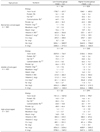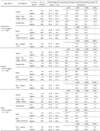Abstract
This study was conducted to evaluate the dietary quality of school-aged children from low-income families in comparison with those from higher income families. The socio-demographic and anthropometric data and one day 24-hour recall dietary intake data of 1,782 school-aged children were used for analysis from the data of 2001 National Health and Nutrition Survey. The children whose family had monthly household income 120% or lower than the 2001 Minimum Cost of Living were classified into Low Income Group (LIG), and the others were classified into Higher Income Group (HIG). The consumption levels of the food groups of the Korean Food Guide as well as the general nutritional status based on their weight and height, energy and nutrient intake were compared between LIG and HIG in elementary (n = 989), middle (n = 432), and high (n = 361) school-aged children, respectively. LIG tended to have lower weight, height, and BMI than HIG, but the difference was significant only in the weight and the BMI of the middle school-aged children. The energy intake of LIG didn't differ from that of HIG, but LIG consumed a higher percentage of energy from carbohydrate and a lower percentage of energy from fat than HIG. Some micronutrient intake was lower in LIG than HIG in case of the elementary and the middle school-aged children. The average numbers of servings of milk · dairy products and fruits consumed by LIG were significantly lower than those consumed by HIG in the elementary and the middle school-aged children, and they were less than the respective recommended serving. The average number of servings of meat · fish · egg · beans consumed by LIG was lower than that consumed by HIG in the middle and the high school-aged children, and it was also less than the recommended serving. The results suggested that the diet of children from low-income families should be intervened by strategies different from the other children in order to improve the consumption level of milk · dairy products, fruits, and meat · fish · egg · beans.
Figures and Tables
Fig. 1
Distribution of subjects' fat and carbohydrate energy intakes according to Acceptable Macronutrient Distribution Ranges. Distributions of subjects are significantly different between the income groups (***: p < 0.001).

References
1. Alaimo K, Olson CM, Frongillo EA. Food insufficiency and American school-aged children's cognitive, academic, and psychosocial development. Pediatrics. 2001. 108:44–53.

2. Lee BJ. Status of Children and Adolescents in Korea. Final report. 2009. Ministry for Health, Welfare and Family Affairs.
3. Drewnowski A, Specter SE. Poverty and obesity: the role of energy density and energy costs. Am J Clin Nutr. 2004. 79:6–16.

4. Mo S, Kim HK. Survey of physical growth and dietary intake of sponcered school-age children in redeveloping community, surburb of Seoul. J Korean Publ Hlth Assoc. 1978. 4(2):51–58.
5. Lee JW, Chung YJ, Kim MR. Nutritional status of school children in Daejon city-focusing on children in two schools with different socioeconomic level-. Korean J Nutr. 1982. 15(1):70–81.
6. Mo S, Chung SJ, Lee SK, Baek SK, Jeon MJ, Han CW. Nutrition survey of children attending an elementary school without a school lunch program, in a low income group of Seoul, 2. A study on nutrient intake. Korean J Nutr. 1990. 23(7):521–530.
7. Chung SJ, Choi SH, Mo SM, Lee SJ. An ecological survey of food and nutrition of children attending an elementary school without a school lunch program in low income group of Seoul. Korean J Food Culture. 1991. 6(4):369–380.
8. Son SM, Chung SK. Nutritional status of 5th grade school children residing in low-income area of Pucheon city. Korean J Community Nutr. 1997. 2(3):267–274.
9. Kim MK, Ki MR, Bang KY, Kim KR, Choi BY, Kwon YJ, Lee SS, Kim C, Kang YJ. The effect of parental socioeconomic status on the nutrient intake of urban and rural adolescents. Korean J Community Nutrition. 1998. 3(4):542–555.
10. Bae EJ, Kwon JH, Yoon HJ, Lee SK. Nutritional status of school lunch supported students in an elementary school. J Korean Dietetic Assoc. 2001. 7(4):349–360.
11. Oh SY, Kim MY, Hong MJ, Chung HR. Food security and children's nutritional status of the households supported by the National Basic Livelihood Security System. Korean J Nutr. 2002. 35(6):650–657.
12. Nam KH, Kim YM, Lee GE, Lee YN, Joung HJ. Physical development and dietary behaviors of children in low-income families of Seoul area. Korean J Community Nutr. 2006. 11(2):172–179.
13. Park NY, Choi YS. Nutritional status of school lunch-supported elementary school children in Gyeongbuk rural area. Korean J Nutr. 2008. 41(4):341–352.
14. National Basic Livelihood Security Law and its Enforcement Ordinance. 2009. Republic of Korea:
15. Ministry of Health and Welfare. The 2001 Minimum Cost of Living. 2002.
16. Korea Centers for Disease Control and Prevention & Korean Society of Pediatrics. Body Growth Standard Values of Korean Pediatrics and Juveniles in 2007. 2007.
17. The Korean Nutrition Society. Dietary Reference Intakes for Koreans. 2005. Seoul:
18. Shim JE, Joung H, Paik HY. Effects of food cost on diet quality. Korean J Nutr. 2006. 39(8):832–840.
19. Olson CM. Nutrition and health outcomes associated with food insecurity and hunger. J Nutr. 1999. 129:2 Suppl. 521s–524s.

20. Poulton R, Caspi A, Milne BJ, Thomson WM, Taylor A, Sears MR, Moffitt TE. Association between children's experience of socioeconomic disadvantage and adult health: a life-course study. Lancet. 2002. 360:1640–1645.

21. Power C, Manor O, Mattews S. Child to adult socioeconomic conditions and obesity in a national cohort. Int J Obes. 2003. 27:1081–1086.

23. Freedman DS, Ogden CL, Flegal KM, Khan LK, Serdula MK, Dietz WH. Childhood overweight and family income. Med Gen Med. 2007. 9(2):26. [on-line].
25. Ong KK. Catch-up growth in small for gestational age babies: good or bad? Curr Opin Endocrinol Diabetes Obes. 2007. 14(1):30–34.

26. Yoon B, Yoon J, Shim JE, Kwon S. Current status of meal box service management for children from low-income families during summer vacation. Korean J Community Nutr. 2009. 14(2):206–215.




 PDF
PDF ePub
ePub Citation
Citation Print
Print








 XML Download
XML Download